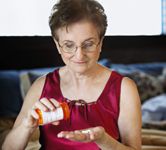Baby boomers trend toward higher drug utilization
As the first of the baby boomers become eligible for Medicare in 2011, the healthcare system is bracing itself to support added burdens on drug utilization

Key Points
RISK PROPOSITIONS will likely change as a reflection of the aging of America, and there are several dynamics to consider. One difference between the baby boomers and adults over age 65, for example, is that the younger group is more likely to address health issues before they become complex, while those over 65 might ignore a diagnosis of high cholesterol or hypertension.

As the first of the baby boomers become eligible for Medicare in 2011, the healthcare system is bracing itself to support added burdens on drug utilization and costs. Add longer life spans and expensive biologics, and payers have cause for alarm.
Fifty percent of seniors take eight or more prescriptions on average, according to CVS Caremark. Seventy percent of 50- to 64-year-olds report having been diagnosed with one or more chronic conditions, and nearly half have two or more, the latter consuming more than 3.5 times the average cost for those with no chronic conditions, as reported by AARP.
Top contributors to the cost trend among baby boomers include diabetes (28.3%), rheumatological (14.6%), and asthma and COPD drugs (14.3%), according to the 2010 Medco Drug Trend Report. Medco also found that as many as 75% of insured Americans in the baby boomer group are currently taking at least one medication for a chronic condition, and more than half are regularly taking three or more drugs.
The report also indicates net plan costs for 50- to 64-year-olds of $1,243 annually.
A study by Quintiles Consulting, a biopharmaceutical services company, looked at new patient prescriptions, total prescriptions and out-of-pocket costs for five age groups: age 18 years or younger; 19 to 35; 36 to 54; 55 to 64; and older than 65. Each were researched for cholesterol, diabetes, depression, hypertension and pain.
Results indicate that 55- to 64-year-olds actually rank second in new patient prescriptions (after the group of 36- to 54-year-olds) and rank third in total prescriptions and out-of-pocket costs (OOP).
"We initially hypothesized that the age 55 to 64 group would have the highest total drug and out-of-pocket costs, so it was certainly surprising that it did not," says Bryan Sepulveda, a consultant with Quintiles. "One may speculate that this may have been a result of the drug classes chosen since more and more younger individuals are being affected by depression and pain. In addition, the Medicare group has the lowest OOP costs than any other group because most private insurance exacts a greater degree of patient cost sharing."
PREVENTION IS KEY
Medco's Dr. Eisenberg says that the most important issue to watch is the increase in brand-name prices.
The average price of branded prescription drugs rose by an annual rate of 9.3% in 2009, the largest growth rate since 2002, according to a report released by AARP. He estimates that aging's impact on expenditures will increase 0.3% to 0.6% annually, making a significant dent 20 years hence.
Dr. Eisenberg is optimistic about the Patient Protection and Affordable Care Act (PPACA). Some provisions could lower costs: phase-out of the Part D donut hole by 2020; the development of accountable care organizations by 2012; and the launch of health insurance exchanges, which will spread risk across a larger pool of individuals.
He says comparative effectiveness research is also an effective tool to help healthcare stakeholders make wiser decisions on how they manage the pharmacy benefit. Personalized medicine is another potential means to ensure more appropriate drug use and helping to keep costs at bay, Dr. Eisenberg says. However, he questions whether insurers will pay for the testing that goes along with it. Personalized medicine has to show return on investment, he says.
David Calabrese of OptumRx Talks New Role, Market Insulin Prices and Other Topics 'On His Mind'
April 13th 2023In this month’s episode of the "What's On Your Mind podcast," Peter Wehrwein, managing editor of MHE connects with the now Chief Clinical Officer of OptumRx Integrated Pharmacies, David Calabrese. In this conversation, David touches on his transition in January as OptumRx’s former chief pharmacy officer and market president of health plans and PBMs to his new role as Chief Clinical Officer where he now focuses more on things such as specialty pharmacy to home delivery — with an overall goal of creating whole-patient care. Throughout the conversation, Calabrese also touched on the market’s hot topic of insulin prices and behavioral health services within the OptumRx community, among other topics.
Listen
Briana Contreras, editor of Managed Healthcare Executive, spoke with Nancy Lurker, CEO and president of EyePoint Pharmaceuticals. Nancy shared a bit about EyePoint and how the organization’s innovative therapies are addressing patient needs through eye care, and most importantly, she addressed C-Suite positions like the CEO role. Nancy shared advice for those seeking to reach the CEO level, especially toward women in healthcare and other roles, and what it takes to run a biopharma company.
Listen